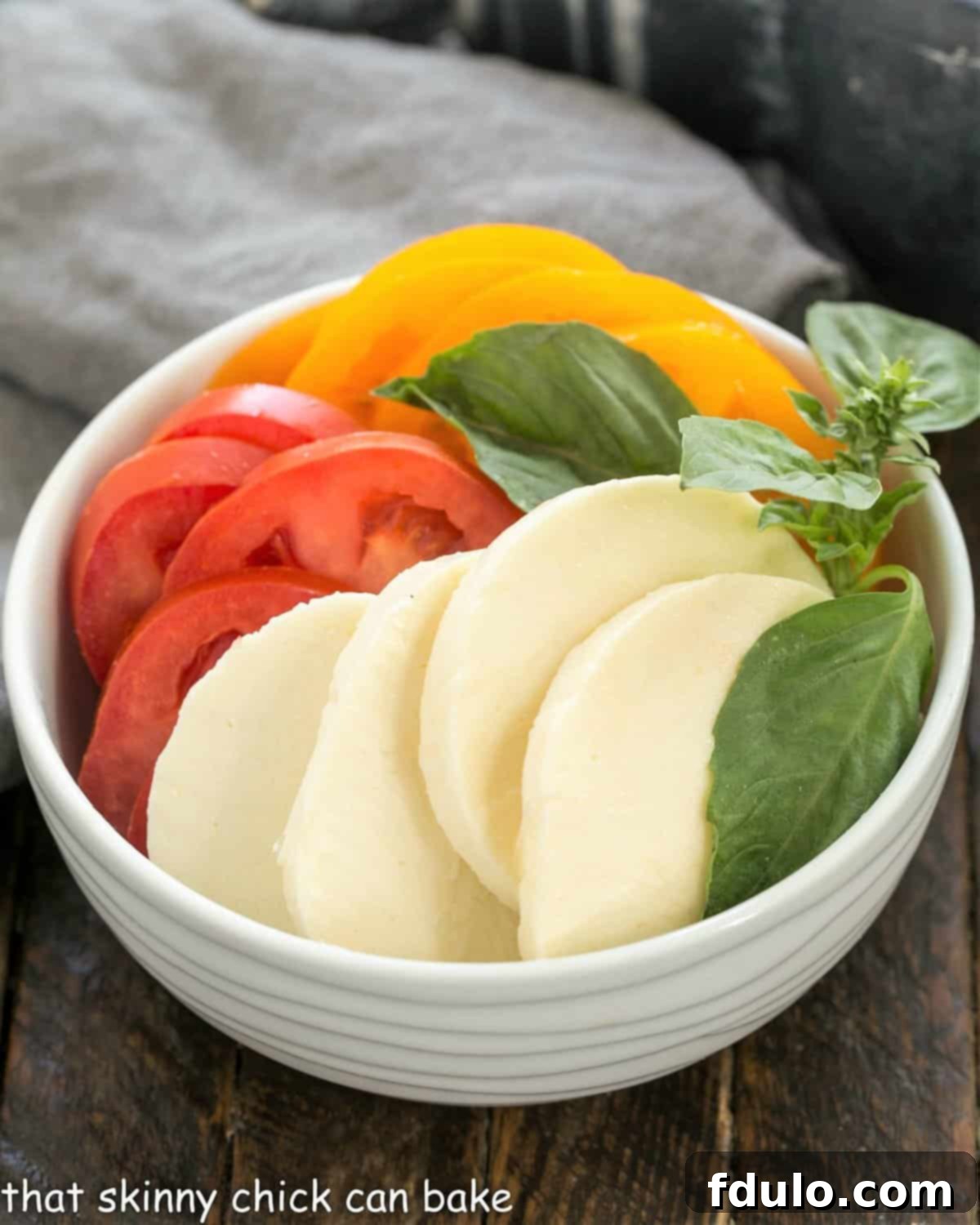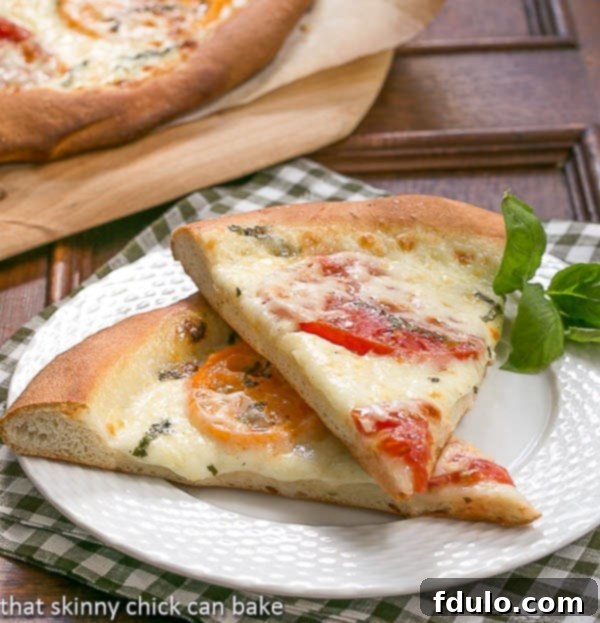Welcome to the ultimate guide for crafting the most incredible Homemade Pizza Margherita! This isn’t just any pizza; it’s a culinary journey to the heart of Italy, right in your own kitchen. Combining the freshest, simplest ingredients – sun-ripened tomatoes, creamy fresh mozzarella, and aromatic basil – this classic pie delivers an unparalleled taste experience that will delight everyone. Forget takeout; this easy-to-make vegetarian pizza recipe promises an authentic flavor that’s impossible to resist, making it a firm family favorite and a perfect choice for any meal.
Often hailed as the best vegetarian pizza, our Caprese Pizza recipe celebrates simplicity and quality. Each bite offers a harmonious blend of flavors, with the crisp, chewy crust providing the perfect foundation for the vibrant toppings. Whether you’re a seasoned chef or a beginner in the kitchen, our detailed instructions and expert tips will guide you to pizza perfection, ensuring a golden crust and bubbly, flavorful cheese every time.

Why You Must Make This Authentic Margherita Pizza
There are countless reasons to add this Homemade Pizza Margherita recipe to your regular meal rotation. It’s more than just a meal; it’s an experience waiting to happen. Here’s why this pizza stands out:
- Unforgettable Crust: Our recipe features a tried-and-true pizza crust that achieves the perfect balance of crispiness and chewiness, providing a sturdy yet delicious base for your toppings.
- Classic, Simple Toppings: With just a few high-quality ingredients – fresh mozzarella, ripe tomatoes, and fragrant basil – this pizza embodies the true essence of Italian culinary tradition. The beauty lies in its simplicity.
- A Universal Crowd-Pleaser: Even the pickiest eaters in our family give this pizza their wholehearted endorsement. It’s a dish that consistently brings smiles to the table, making mealtime a joyous occasion.
- Perfect for Any Occasion: From cozy Friday night dinners to vibrant family gatherings and even as a thoughtful meatless option during Lent, this Margherita pizza fits seamlessly into any plan. Serve it alongside a crisp seasonal salad, and you have a budget-friendly, satisfying meal that never disappoints.
Our family, famously discerning when it comes to food, instantly fell in love with this vegetarian pizza. Its fresh flavors and comforting nature made it an immediate hit and a permanent fixture on our menu. It even rivaled the excitement for a hearty Mexican Pizza or a robust sausage and mushroom pizza, proving its universal appeal.
Making pizza from scratch is an incredibly rewarding process. There’s a unique satisfaction that comes from kneading the dough, watching it rise, and then transforming simple ingredients into a masterpiece. This recipe empowers you to create restaurant-quality pizza in your own home, offering a customizable and healthier alternative to store-bought options.

Ingredient Notes for the Perfect Pizza Margherita
The secret to an exceptional Pizza Margherita lies in the quality and freshness of its ingredients. Here’s a detailed look at what you’ll need and why each component is vital:
- Pizza Dough: While a store-bought option like Trader Joe’s pizza dough (found in the refrigerator section) offers convenience for busy days, nothing compares to the flavor and texture of homemade dough. This recipe includes instructions for a superior homemade crust that truly elevates the pizza.
- Bread Flour: Essential for a classic pizza crust. Bread flour has a higher protein content than all-purpose flour, which means more gluten. This extra gluten develops into a strong, elastic dough that results in a wonderfully chewy and structured crust that can withstand the heat and hold its shape.
- Instant Yeast: This type of yeast is incredibly convenient as it does not require prior dissolution in liquid. It can be mixed directly with the dry ingredients, making the dough-making process quicker and simpler. Ensure your yeast is fresh for optimal rising.
- Sugar: A small amount of sugar acts as food for the yeast, helping to activate it and encourage a robust fermentation process. It also contributes to the beautiful browning of the crust.
- Salt: Far more than just a seasoning, salt is imperative for enhancing the overall flavor of the dough. It also helps to control the yeast’s activity, preventing it from rising too quickly and allowing for better flavor development.
- Ice Water: Using ice water slows down the yeast’s activity, which is crucial for a slow, cold fermentation process. This extended fermentation allows the dough to develop complex flavors and a superior texture, contributing to that desired artisanal quality.
- Olive Oil (for Dough): A touch of olive oil adds richness, tenderness, and a subtle fruity note to the dough, making it more pliable and easier to work with. It also aids in achieving a crisp exterior.
- Tomatoes: The choice of tomatoes dramatically impacts the pizza’s flavor. In winter, opt for meatier plum tomatoes, which have less water content. During summer, thinly sliced, ripe garden tomatoes are absolutely divine. Whichever you choose, ensure they are thinly sliced and thoroughly drained on paper towels to prevent a soggy crust.
- Fresh Basil: The vibrant aroma and peppery-sweet flavor of fresh basil are indispensable for a true Margherita. Roll up the leaves like a cigar (a technique called chiffonade) and slice them thinly for easy sprinkling and even distribution across the pizza. Growing your own basil in the summer ensures a constant supply of this hardy herb.
- Mozzarella: For an authentic experience, sliced balls of fresh mozzarella cheese are highly recommended. Their creamy texture and gentle melt are superior. While shredded mozzarella can be used, fresh mozzarella yields a more traditional and flavorful result. Patting it dry can also help prevent excess moisture.
- Kosher Salt and Pepper: A generous sprinkle of kosher salt over the cheese and tomatoes before baking amplifies all the flavors. Freshly ground black pepper adds a subtle kick and aromatic depth.
- Olive Oil (for Topping): A light drizzle of good quality extra virgin olive oil over the assembled toppings before baking adds a final layer of flavor, richness, and that quintessential Italian touch.
Basic Steps to Homemade Pizza Margherita Perfection
Making pizza from scratch might seem daunting, but it’s incredibly rewarding. Here’s a simplified overview of the process to get you started on your journey to the perfect homemade Pizza Margherita:

- Prepare the Dough: Begin by mixing your pizza dough ingredients. Once combined, cover it and allow it to proof slowly in the refrigerator for optimal flavor development. This crucial step is key to a flavorful crust.
- Shape and Top: After the dough has proofed, gently work it into a round shape. Place it onto a sheet of parchment paper, which will make transferring and cleanup much easier.
- Bake to Golden Perfection: Generously add your fresh toppings, then transfer the pizza to a preheated oven. Bake until the crust is beautifully browned, crisp, and the mozzarella cheese is wonderfully bubbly and melted.

Detailed Steps for Crafting Your Homemade Margherita Pizza
Achieving a truly exceptional Homemade Pizza Margherita requires attention to detail. Follow these steps for a perfect pie every time:
- Verify Your Yeast: Before you begin, always check the activity of your yeast. Look for an expiration date on the package. If you’re unsure or using bulk yeast, dissolve a pinch of sugar in some warm (not hot!) water and add a little yeast. If it starts to bubble and foam within 5-10 minutes, your yeast is active and ready to go.
- PRO-Tip for Yeast Storage: To ensure your yeast remains active for years, store it in the freezer! Just transfer it to an airtight container. This preserves its potency much longer than refrigeration or pantry storage.
- Kneading the Dough: Follow the recipe carefully to mix and knead your dough. For a stand mixer, start with the paddle attachment to combine ingredients, then switch to the dough hook for kneading. Knead until the dough is smooth, elastic, and slightly sticky to the touch. This process develops the gluten, which is vital for the crust’s texture.
- Cold Proofing for Flavor: Unlike many bread recipes, this pizza dough proofs slowly in the refrigerator, not in a warm spot. For the best flavor, allow the dough to refrigerate overnight, or even up to 72 hours. This long, cold fermentation gives the yeast ample time to develop complex flavors and structure, resulting in a much more delicious and digestible crust.
- Shaping the Dough: Once your dough has completed its single proofing cycle, it’s time to shape it. Gently stretch the dough by placing it on the back of your hands and letting gravity assist. Use your thumbs and knuckles to rotate and slowly stretch it outwards.
- Final Shaping on Parchment: After the initial stretching, place the dough onto a sheet of parchment paper. Continue to gently press and stretch with your fingers, working from the center outwards, until you achieve a nice, even circle of your desired thickness. Parchment paper makes transferring the pizza to the oven a breeze and simplifies cleanup.
- Preheat for Perfection: Preheat your oven to a high temperature, ideally 550ºF (287°C), with your pizza stone or steel inside. Allow the stone to preheat for at least 30-60 minutes to ensure it reaches a scorching hot temperature. This intense heat is crucial for achieving a crispy, leopard-spotted crust.
- PRO-Tip for Toppings: Do not overload your pizza with toppings, and ensure any soft ingredients, especially tomatoes, are free of excess liquid. Thinly slice your tomatoes and drain them on paper towels to remove as much moisture as possible. Excess moisture from toppings can make your crust gummy instead of crisp. Even if it gets a little gummy, it’ll still be tasty, but for optimal crispness, manage that moisture!
- Baking and Cooling: Once topped, use a pizza peel to slide the pizza and its parchment paper directly onto the preheated pizza stone in the oven. Bake until the crust is golden brown and the cheese is beautifully bubbly and lightly browned in spots. Carefully remove the pizza with the peel and transfer it to a cooling rack.
- The Benefits of Homemade Dough: This recipe yields enough dough for two pizza crusts. You can use both immediately or freeze half the dough for another meal. Having homemade pizza dough ready to go in the freezer is a fantastic way to enjoy quick, delicious pizza any night of the week.

Expert Tips for a Perfect Pizza Margherita
Elevate your Homemade Pizza Margherita from great to absolutely extraordinary with these essential expert tips:
- The Magic of Cold Proofing: As mentioned in the detailed steps, this pizza dough is designed for a slow, cold proof in the refrigerator, rather than a quick rise in a warm spot. This extended period (24-72 hours) is not just about convenience; it’s fundamental for allowing the dough to develop profound depth of flavor and a superior, more digestible structure. Don’t rush this step!
- Handling Elastic Dough: Your homemade dough will be wonderfully elastic. This can sometimes make shaping a round challenging. Take your time, gently stretching and allowing the dough to rest for a minute or two if it springs back too much. Patience is key to achieving a beautifully shaped crust.
- Parchment Paper is Your Friend: Always shape your dough on a sheet of parchment paper. This simple trick makes transferring the topped pizza to a scorching hot pizza stone incredibly easy and safe, preventing sticking and making cleanup a breeze. It’s a game-changer for homemade pizza.
- Mastering the Pizza Peel: If you’re a serious pizza maker, a pizza peel is an invaluable tool for sliding your pizza onto and off the hot stone. If you don’t have one, a rimless baking sheet or even the back of a regular baking sheet can serve as a suitable substitute. Dust it lightly with flour or cornmeal to prevent sticking.
- Don’t Skimp on Preheat Time: The oven and pizza stone need ample time to reach and maintain a high temperature. A well-preheated stone ensures instant crisping of the crust upon contact, mimicking professional pizza ovens.
- The Cooling Imperative: Once your pizza emerges from the oven, resist the urge to cut into it immediately. Transfer it to a cooling rack and let it rest briefly for a few minutes. This allows the scorching hot cheese to set slightly, preventing it from burning the roof of your mouth and ensuring a cleaner slice.
- Consider a Pizza Stone or Steel: Investing in a pizza stone or steel can dramatically improve your homemade pizza. These conductive surfaces retain and transfer heat efficiently, giving you that coveted crispy bottom crust.
- Flavor Boosters: For an extra layer of flavor, consider brushing the edges of your pizza crust with a little olive oil or garlic-infused olive oil before baking. This adds aroma and helps achieve a golden-brown finish.
Frequently Asked Questions About Pizza Margherita
Absolutely! Pizza Margherita is deeply rooted in Italian culinary tradition, originating in Naples (Napoli). Its traditional toppings are simple yet iconic: San Marzano tomatoes, fresh mozzarella, fresh basil, a touch of salt, and a drizzle of extra virgin olive oil. This combination not only offers exquisite flavor but also beautifully represents the colors of the Italian flag.
There are a couple of charming theories about the origin of the name “Pizza Margherita.” One popular theory suggests the name comes from the flower-like arrangement of the ingredients on the dough, as “Margherita” translates to “daisy” in Italian. The most widely accepted and romanticized story, however, dates back to 1889. Queen Margherita of Savoy, during a visit to Naples, reportedly grew tired of the elaborate French cuisine she was being served. She summoned the renowned local pizza maker, Raffaele Esposito, to prepare some traditional Neapolitan pizzas. Among them, she particularly enjoyed a pizza topped with fresh mozzarella, vibrant tomatoes, and aromatic basil – ingredients that coincidentally mirrored the red, white, and green colors of the Italian flag. In honor of the Queen, Esposito named this patriotic and delicious creation “Pizza Margherita.”
A good homemade pizza dough is characterized by its elasticity, flavor, and texture. Key elements include using bread flour for strong gluten development, proper hydration (often with cold water for a slow rise), and a long, cold fermentation period. This slow proofing allows for complex flavors to develop, resulting in a chewy, airy, and delicious crust.
While fresh tomatoes are ideal, especially during peak season, high-quality canned San Marzano tomatoes (crushed or whole and then crushed by hand) are an excellent alternative, particularly in winter. They offer a balanced sweetness and acidity. Be sure to drain them well to avoid a soggy crust.
Achieving a super crispy crust relies on several factors: a very hot oven (500-550°F), preheating a pizza stone or steel for at least 30-60 minutes, a well-drained dough (low moisture), and avoiding overloading with toppings. The intense, direct heat from the stone sears the bottom of the crust, creating that desirable crispness.
You May Also Like
Once you’ve mastered this Homemade Pizza Margherita and stocked up on yeast, you’ll undoubtedly want to explore more delicious yeast bread recipes. Here are some of our family’s other favorites:
- Classic Oatmeal Bread
- The NYT No-Knead Bread
- Pumpernickel Bread Recipe
- Homemade Pretzel Rolls
- Plus, you might enjoy this Easy Pizza Bake
- Discover more Yeast Bread Recipes for your baking adventures.
Stay in touch through social media @ Instagram, Facebook, and Pinterest. Don’t forget to tag me when you try one of my recipes! And if you love the results, please give it a 5-star rating in the recipe card below.

Homemade Pizza Margherita
20 minutes
15 minutes
35 minutes
1 pizza
My family’s favorite pizza, an easy-to-make classic Margherita with fresh ingredients!
Ingredients
Dough:
- 3 cups bread flour plus more to dust the work surface
- 2 teaspoons sugar
- ½ teaspoons instant yeast (I use Red Star Platinum Yeast)
- 1 ⅓ cups ice water
- 1 ½ teaspoons salt
- 1 tablespoon olive oil plus more to oil the work surface
Topping:
- 2 8-ounce balls of fresh Mozzarella, sliced and patted dry
- 4 medium to large garden tomatoes or 8-10 plum tomatoes, cut into thin slices and drained on paper toweling
- Fresh basil, cut into thin strips (chiffonade)
- Kosher salt
- Freshly ground black pepper
- Extra virgin olive oil
Instructions
- Place the flour, sugar, and yeast into the bowl of a food processor. Process for a couple of seconds until combined.
- Slowly add the cold water through the feed tube with the processor running. Mix until the dough is combined, about 10 seconds.
- Let the dough rest for 10 minutes.
- Add the oil and salt and process until the dough cleans the side of the bowl, a minute or less. Remove the dough and knead on a lightly oiled surface until smooth and elastic.
- Form the dough into a ball and place it into an oiled bowl. Cover with plastic wrap and refrigerate for 24-72 hours for best flavor development.
- When ready to make the pizza, divide the dough in half. Shape each half into a dough ball and place on an oiled baking sheet. Cover with greased plastic wrap and let rest at room temperature for 1 hour. (This recipe makes enough for two pizzas; freeze half the dough if desired).
- Place the pizza stone into the oven and preheat to 500ºF (260°C). Allow it to preheat for 30-60 minutes in advance to get the stone thoroughly heated.
- Pat out one half of the dough into a large circle, about 12 inches in diameter, onto a sheet of parchment paper. Repeat with the second ball of dough if making two pizzas.
- Top the dough with drained tomato slices, and then arrange the fresh mozzarella slices. Season with kosher salt, freshly ground black pepper, and sprinkle with fresh basil strips. Drizzle lightly with extra virgin olive oil.
- Using a pizza peel, slide the pizza (with the parchment paper underneath) onto the preheated pizza stone in the oven.
- Bake for about 10-15 minutes, or until the crust is golden brown and crispy, and the cheese is bubbly and slightly browned in spots.
- Carefully remove the pizza with the peel to a cooling rack. Let cool briefly for a few minutes before slicing and serving, as the cheese will be scorching hot.
Notes
Dough recipe adapted from Cook’s Illustrated (note that this recipe will make enough for 2 pizzas).
Freeze half the dough if desired (only use half the toppings per pizza).
The total time listed does not reflect the optional cold proofing time for the dough.
Recommended Products
As an Amazon Associate and member of other affiliate programs, I earn from qualifying purchases.
- Reynolds Cookie Baking Sheets Non-Stick Parchment Paper, 25 Sheet, 4 Count
- Pizza Cutter
- Pizza Peel
Nutrition Information:
Yield:
4
Serving Size:
1
Amount Per Serving:
Calories: 782Total Fat: 33gSaturated Fat: 14gTrans Fat: 0gUnsaturated Fat: 17gCholesterol: 73mgSodium: 3646mgCarbohydrates: 86gFiber: 5gSugar: 8gProtein: 35g
HOW MUCH DID YOU LOVE THIS RECIPE?
Please leave a comment on the blog or share a photo on Pinterest
